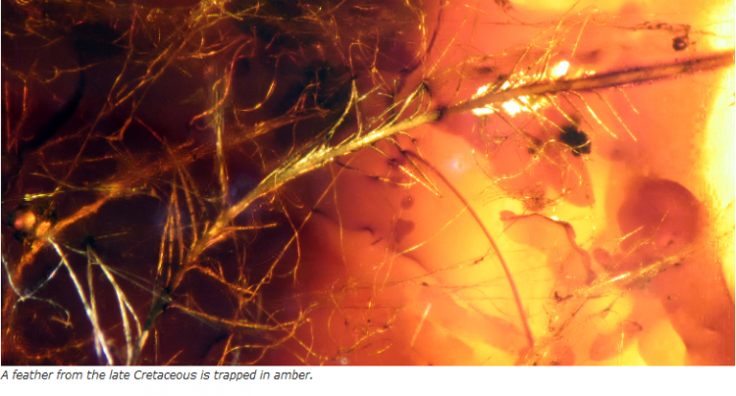Feathers Found in Amber Reveal Colorful Dinosaur Age

Researchers have discovered a rich collection of ancient colored feathers that have been preserved and fossilized in tree sap in Canada.
A research team from the University of Alberta has uncovered many feathers trapped in tree resin that turned into resilient amber. Scientists believe the tiny bits of feathers may have come from non-avian dinosaurs from the late Cretaceous period.
According to the study published Thursday in the journal Science, Ryan McKellar, a paleontology graduate student of the University of Alberta, and colleagues have discovered 11 preserved feathers among the massive amber collections at the Royal Tyrrell Museum in southern Alberta.
The amber is part of a huge collection holding bits of animals and birds, entire insects, parasites, and segments of tree bark - all from 70 to 80 million years ago and stored at the museum, the San Francisco Chronicle reported.
Researchers reportedly sanded down and polished the amber pieces millimeters away from the feathers, allowing them to get an up-close look at the trapped feathers. The process allowed them to see the pigments that once colored the feathers, many of which were dark gray or brown, while others were transparent.
All the feathers are preserved down to micron scale, showing indentations and pigmentation. It's also the first time we've found proto-feathers [feathers thought to belong to non-avian dinosaurs] preserved in amber, McKellar told LiveScience.
“The amber preserves microscopic detail of the feathers and even their pigment or color. I would describe the colours as typically ranging from brown to black,” he said in a university release.
One researcher said feathers had been found on much older fossils, but the new samples suggest the feathers continued to develop into a modern form, even after the extinction of dinosaurs.
Although no dinosaurs or avian fossils were found in direct association with the amber specimens, McKellar said that comparison between the amber and other fossilized feathers found in the rock suggests some of the new specimens are from dinosaurs. In particular, non-avian dinosaur evidence suggests the feathers may have come from small theropods.
McKellar says that some of the feather specimens can take on water, enabling the bird to dive more effectively and are very similar to those of modern birds like the grebe, which are able to swim underwater.
© Copyright IBTimes 2025. All rights reserved.





















